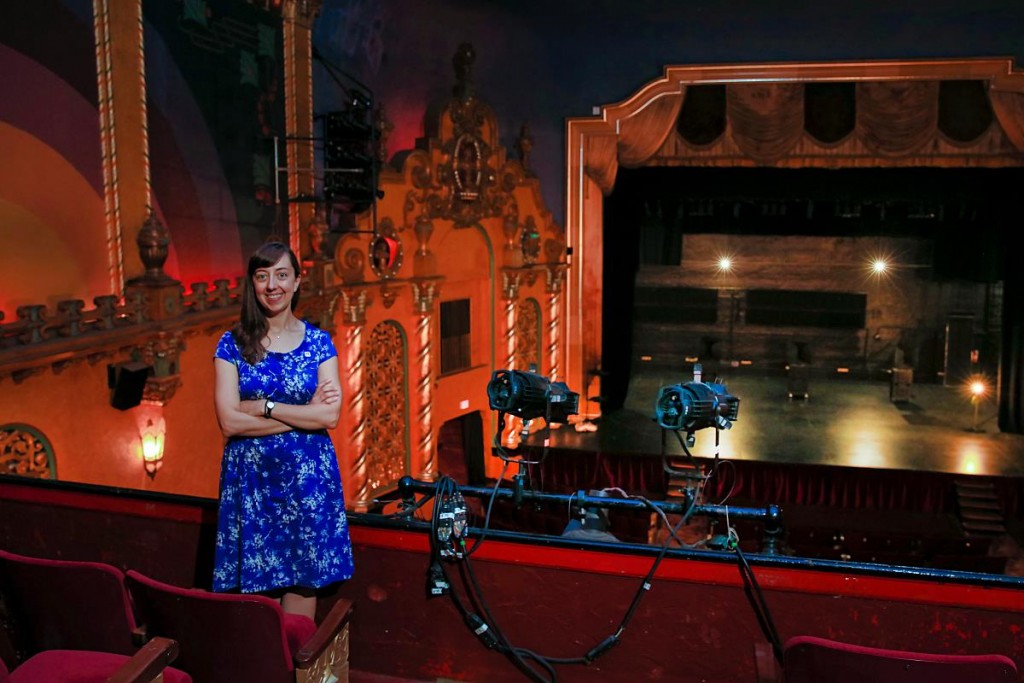SMITH HISTORY BLOG Movies Under the Stars: The Atmospheric Style
by Gretty Hollister
Marcus Loew, the theatre entrepreneur who would go on to help form the mega-movie conglomerate Metro-Goldwyn-Mayer (MGM), is credited as having once said, “Patrons buy tickets to theatres; not movies” (“Movie Palaces” 4:57). Back in the 1930s, half the fun of going to the movies was going to the actual theatres themselves. Before our multiplexes with multiple screens and advanced showings and all the latest and greatest, the single-screen movie palace was just that: a palace.

Behind Smith Board Member Chris Woodworth, you can see one of the elegan cartouches that define The Smith’s “Atmospheric Style.”
In the 1920s, an Austro-Hungarian immigrant named John Eberson (EE-ber-son) made popular a new style. Instead of making his patrons imagine that they were in a European opera house (as late 19th-century opera houses and early 20th century movie palaces had), Eberson’s atmospheric theatres transported the patrons to a European courtyard—in Renaissance Italy, or Spanish Andalusia, or even the quaint British countryside—complete with a starry night sky above them (Wilkins). Atmospheric theatres began popping up all over the U.S. as the movie palace became more popular and more accessible.
In our own Geneva, Schine Enterprises, Inc. was still a relatively small company in 1931, but the Geneva Theatre was going to be their flagship for Western New York. The architect, Victor A. Rigaumont, was obviously inspired by Eberson’s work and proposed designing the theatre’s auditorium in the atmospheric style. It’s hard not to lose one’s breath when you walk into the Smith’s auditorium. Rigaumont wanted to give the theatre the impression of a “Moorish” courtyard.* To achieve this, he incorporated elements that he saw as foreign and exotic. On either side of the stage, instead of facades as in some theatres, there are cartouches (archways featuring scroll-like ornamentation) with three busts at the top of each. The walls are painted with gold travertine, above which plaster work gives the impression of a palace wall. Above the plaster is the fresco of a sunset with hidden lighting. As the lights dim, the sun sets, illuminating the sky above the audience. Lights twinkle in a blue plaster ceiling that curves at the front and sides, giving the impression of a starry night sky.
Beautifully restored in the 1990s, the Smith Opera House’s auditorium has maintained this atmospheric style into the 21st century. Many other atmospheric theatres and early 20th century movie palaces were not so lucky, getting demolished to make way for parking lots or shopping malls, or new movie multiplexes. The Smith and the other remaining movie palaces in the U.S. live on as a testament to the power that movie theatres had on the common man, who may never have gotten to sit in an actual European courtyard but could lay back in an atmospheric theatre and swear that he could almost feel the wind on his face.
Be sure to also read our blog post on Cultural Appropriation in early 20th century movie palaces.
Works Cited:
“About the Indiana Theatre.” Indiana Theatre, https://www.indianatheater.com/about-us. Accessed 6 July 2018.
“Movie Palaces, with Gene Kelly.” YouTube, uploaded by 20C History Project, 7 June 2015, https://www.youtube.com/watch?v=lhzWo6sfZiM.
Wilkins, Randall. “Atmospheric Theatres—When the Theatre was Part of the Show.” The Designer’s Assistant, https://thedesignersassistant.com/tag/john-eberson/. Accessed 6 July 2018.